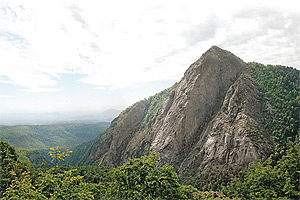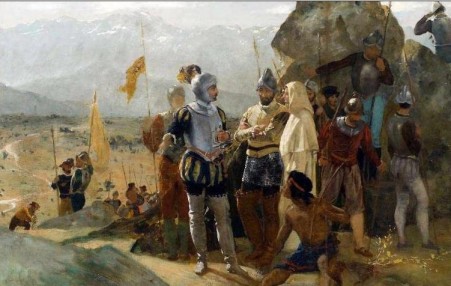The characteristics of the flora and fauna in this region are similar to the region of O’Higgins. However, in Maule, the population of species that are adapted to humid environments increases.
– Sector west of the Coastal mountain range: here, the sclerophyll forest (which is born in the region of Valparaiso) is slowly replaced by the coastal deciduous forest, with an abundance of plant species. A few of the most representative one are: the Hualo (Nothofagus glauca), Maqui (Aristotelia chilensis), Maquicillo (Azara petiolaris), Roble (Nothofagus obliqua), Coigüe (Nothofagus dombeyi), Ruil (Nothofagus alessandrii), Corontillo (Escallonia pulverulenta), Chilean hazel (Gevuina avellana), Mayo (Sophora macrocarpa), Piñol (Lomatia dentada), long-leaved Mañio (Podocarpus saligna), Chilean myrtle (Luma apiculata), Palmilla (Blechnum auriculatum), boqui blanco (Boquila trifoliolata), miniature grape ivy (Cissus striata), Lluvia de oro (Cytisus monpessulanus), Raran (Myrceugenia obtusa), Zarzaparrilla (Ribes punctatum), bay laurel (Laurus nobilis) and Colliguay macho or Lechon (Adenopeltis serrata).
Meanwhile, fauna in this forest is scarce, only a few mammals are present, with highlights being the long-haired grass mouse (Abrothrix longipilis), the olive grass Mouse (Abrothrix olivaceus), the bridge’s degu (Octodon bridgesi), darwin’s leaf-eared Mouse (Phyllotis darwini), the coypu (Myocastor coypus), the Eastern red bat (Lasiurus boreales), the South American gray fox (Pseudalopex griseus), the lesser grison (Galictis cuja), the colocolo (Lynchailurus colocolo) and the pudu (Pudu pudu).
A few birds may also be observed, such as the Chilean pigeon (Columba araucana), the barn owl (Tyto alba), the pared dove (Zenaida auriculata), the Chilean flicker (Colaptes pitius), the striped woodpecker (Picoides lignarius), the plain-mantled tit-spinetail (Leptasthenura aegithaloides), the White-throated treerunner (Pygarrhichas albogularis), the house Wren (Troglodytes aedon) and the Jilguero (Carduelis barbatus).
– High sectors and eastern slope of the coastal mountain range: there is more aridity, reason for which vegetation is made up of large trees, mixed with species from the deciduous forest and a highly developed undergrowth. The most outstanding ones are: the hawthorn (Acacia cavens), the Huañil (Proutia cuneifolia), the Maiten (Maytenus boaria), the Litre (Lithraea caustica), the Peum (Cryptocarya alba), the Boldo (Peumus boldus), the Quillay (Quillaja saponaria), the Temu (Blepharocalyx cruckshanksii), the Patagua (Crinodendron patagua), the Romerillo (Baccharis linearis), the Chagual (Puya chilensis), the Llanten (Plantago hispidula), the Tembladera (Briza minor) and the Oreganillo (Satureja gilliesii). Fauna is similar to the western part, only a few birds of prey are present, such as the red-backed hawk (Buteo polyosoma) and the Harris’s hawk (Parabuteo unicinctus).
– Pre-mountainous and mountainous area: in the former, the deciduous forest does not have many changes, there are only increases in the population of Chilean myrtle (Luma apiculata), palmilla (Lomatia ferruginea), Colliguay (Colliguaja salicifolia) and White Chilean Myrtle (Luma chequen).
In the high part of this mountainous chain, one may see the appearance of the montane deciduous forest, which reaches its maximum development in the region of Biobio. The most typical species are: the roble (Nothofagus oblicua), the olivillo (Aextoxicon punctatum), the coihue (Nothofagus dombeyi), the cordilleran cypress (Austrocedrus chilensis), the hualo (Nothofagus glauca), el winter’s bark (Drimys winteri), the Rauli (Nothofagus alpina), the Chilean rhubarb (Gunnera tinctoria), the Michay (Berberis actinacantha), the Chilean hazel (Gevuina avellana) and the Palito negro (Adiantus sulfureum).
When it comes to fauna, a few mammals stand out, such as the monitor del monte (dromiciops gliroides), the dwarf armadillo (Euphractus pichiy), the long-tailed pygmy rice rat (Oligoryzomys longicaudatus), the olive grass mouse (Abrothrix olivaceus), the Andean long-clawed mouse (Chelemys macronyx), the Patagonian chinchilla mouse (Euneomys chinchilloides), the southern viscacha (Lagidium viscacia), the small big-eared brown bat (Histiotus montanus), the wildcat (Lynchaulurus colocolo) and the cougar (Puma concolor). Among the birds, one may find the black-chested eagle buzzard (Geranoaetus melanoleucus), the Andean condor (Vultur gryphus), the rufous-tailed hawk (Buteo ventralis), the fire-eyed diucon (Pyrope pyrope), the house wren (Troglodytes aedon), the picui ground-dove (Columbina picui) and the rufous banded miner (Geositta rufipennis).
Protected zones
– Radal Siete Tazal National Park: decree Nº15 of the Ministry of National Assets was published in the Official Daily on August 6th, 2008, which established that this reserve was to become this region’s first national park.
This new park belongs to the comuna (county) of Molina. It has 5,148 hectares and its main attraction are the seven waterfalls of the Claro river, which generate enormous pools, all set amidst basaltic rocks and lush endemic vegetation. In addition, one may see the Velo de la Novia (Bride’s Veil) and La Leona waterfalls.
– Torca Lagoon National Reserve: created in 1996, it is found in the comuna (county) of vichuquen, 120 km from Curico. It has a surface area of 604 hectares and is split into three sectors:
-
Llico forest: it is mainly comprised of two introduced species (pine and eucalyptus), which were planted by German Federico Albert to contain the inland advance of dunes.
-
Torca lagoon: it is surrounded by totora, reason for which it is home to hundreds of birds, with standouts such as black-necked swans, coscoroba swans, red ducks and tagua ducks.
-
Cerrillo islet: it has a surface area of two hectares, which are covered in the last areas of sclerophyll forest.
– Altos de Lircay National Reserve: it is located 66 km from Talca, in the cordilleran sector, surrounding the northern bank of the Lircay river. It was created in 1996 and it spans 12,163 hectares, where one may find the montane deciduous forest, mainly made up of robles, coigües, ruils and cordilleran cypresses.
It is inhabited by mammals such as cougers, pudus and the culpeo fox; and birds, like hummingbirds, wood pigeons and loicas.
– Los Bellotos de Melado National Reserve: created in 1995, it is located in the Andean foothills of Linares and is comprised on 417 hectares.
It is one of the few environments where the southern belloto grows (Beilschmiedia berteroana) , in addition to peumos and litres. Regarding fauna, one may see birds that include the white-winged black tyrant (Knipolegus aterrimus) and the house Wren (Troglodytes aedon).
– Federico Albert National Reserve: it is located in the comuna (county) of Chanco (province of Cauquenes); it has 145 hectares and was created in 1981. In its forest, ones may see endemic species, such as boldos, maytens, peumos, maquis and litres.
– Los Ruiles National Reserve: located in this region’s Coastal mountain range, it has a surface of 45 hectares and was created in 1982. It is split into two sectors, El Fin (The End), in the comuna (county) of Empedrado, and Los Ruiles, in the comuna (county) of Chanco. Its main objective is to safeguard the Ruil (Ntothofagus alessandrii), one of the region’s endemic trees that is currently having conservation problems.
– Los Quules National Reserve: created in 1995, it is located 71 km from Cauquenes and has a surface of 147 hectares. It has wooded vegetation and large trees, like the Queule (Gomortega keule) and the Pitao (Pitavia punctata), which both have conservation problems. There are also peumos, hualos and huallipataguas.








